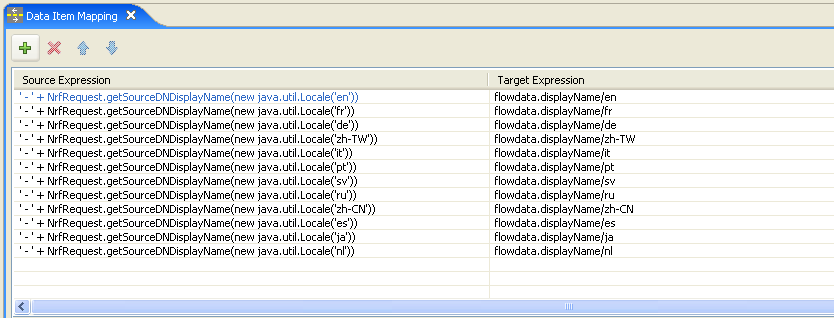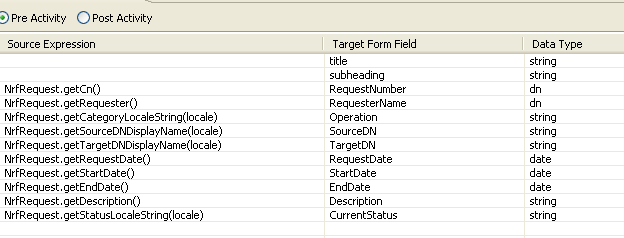6.6 Guidelines for Creating Roles Based Workflows
Roles based workflows must follow the same guidelines outlined in Section 6.5, Guidelines for Creating Workflows. In addition, roles based workflows have their own unique requirements. They are described in the following sections:
6.6.1 About Role Approval Workflows
Role approval workflows are specialized workflows that provide support for role approval and revocation on the User Application’s tab. The Roles Based Provisioning Module includes a read-only Role Approval workflow (named Role Approval) whose design pattern supports:
-
The ability to process role approvals in either serial or quorum mode.
-
The retrieval of approver DNs from the role object (nrfRequest). If you create a custom workflow, the approvers must be defined in the workflow; however, this might lead to addressee evaluation problems and less security concerning who can approve a role.
-
The ability to display the role using localized display names.
-
All nrfRequest object mappings for request and approval forms.
-
Logging and reporting functions.
-
Read-only display of request information. The role approval workflow does not allow changes to the request. Approvers have only the ability to approve or deny the role request.
-
An e-mail notification is sent to all approvers of role approval workflows. A completed notification e-mail is sent upon completion of the role approval workflow. The recipient e-mail address is used when the workflow is intended to be assigned to a user identity.
This pattern is shown in Figure 6-6.
Figure 6-6 Default Role Approval Workflow
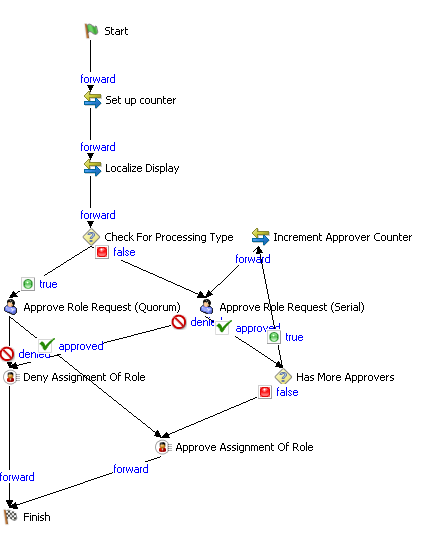
The components of this workflow, and their responsibilities are summarized in Table 6-9.
Table 6-9 Standard Role Approval Activities
To use the standard Role Approval workflow in your user application, you must specify your own users as Trustees. For information on setting the Trustees property, see Section 4.2.6, Modifying Settings of a Provisioning Request Definition.
6.6.2 Writing Custom Role Workflows
If the standard role approval workflow does not support your business needs, and cannot be customized to do so, you can write your own. At a minimum, a custom role approval workflow must:
-
Contain two Role Binding activities
One Role Binding activity must be set to approved and the other set to denied. You must link each of the Role Binding activities to the Finish activity. If the workflow does not meet this requirement, it is invalid, and Designer prevents you from deploying it. The Role Service driver needs these values to set the status for the workflow and to then apply the logic to associate the role to the identity.
-
Contain the following control in the request form:
-
Form Field Name: nrfRequestDN
-
Data Type: Role Request
-
Control Type: Text
-
-
Instantiate the nrfRequestDN in the Pre Activity Data Item Mapping.
-
Contain the following in the Post Activity Data Item Mapping:
-
Source Form Field: nrfRequestDN
-
Target Expression: flowdata.nrfRequestDN
-
Data Type: dn
-
-
Not contain the following ECMA expressions in the Data Item Mapping or Properties definitions because they might return null:
-
getApprovalDN()
-
getAllApproversDN()
-
getAllSodApproversDN()
Because Designer and the User Application user interface do not allow entry of approvers for custom role approval workflows, you must specify the approvers in the workflow itself. Therefore, if you create a custom workflow based on a copy of the Role Approval or SoD Conflict Approval provisioning request definitions, you must remove the ECMA methods from Data Item Mapping or Properties definitions.
-
In the following example, a user requests a role and the user’s manager approves it.
Figure 6-7 Sample Custom Role Approval Workflow
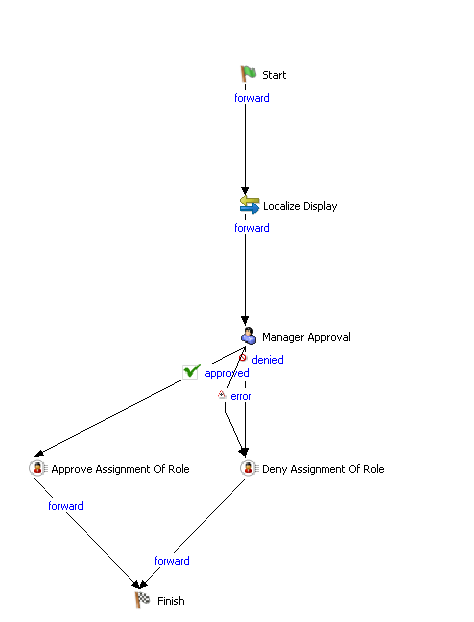
The components of this workflow, and their responsibilities are summarized in Table 6-10.
Table 6-10 Sample Custom Workflow Components
The data item mapping for the sample custom role approval workflow is defined in Table 6-11
Table 6-11 Sample Custom Role Approval Workflow Data Item Mapping
6.6.3 About Separation of Duties Approval Workflows
Separation of Duties approval workflows are specialized workflows that allows a Separation of Duties constraint to be overridden. The Roles Based Provisioning Module includes a read-only Separation of Duties Approval workflow (named SoD Conflict Approval) whose design pattern supports:
-
The ability to process SoD conflicts in either serial or quorum mode.
-
The retrieval of SoD approver DNs from the request object (nrfRequest). If you create a custom workflow, the approvers must be defined in the workflow; however, this might lead to addressee evaluation problems and less security concerning who can approve an SoD.
-
The ability to display the SoD using localized display names.
-
All nrfRequest object mappings for request and approval forms.
-
Logging and reporting functions.
-
Read-only display of requests. Approvers can only approve or deny the SoD conflict.
-
An e-mail notification is sent to all approvers per SoD conflict found for SoD workflow approvals. A completed notification e-mail is sent upon completion of the SoD approval workflow. The recipient e-mail address is used when the workflow is intended to be assigned to a user identity.
This pattern is shown in Figure 6-6.
The roles subsystem allows one Separation of Duties approval flow for the Role subsystem. If you choose to use a custom SoD approval flow, make sure that it works for all SoD situations.
Figure 6-8 Standard SoD Approval Workflow
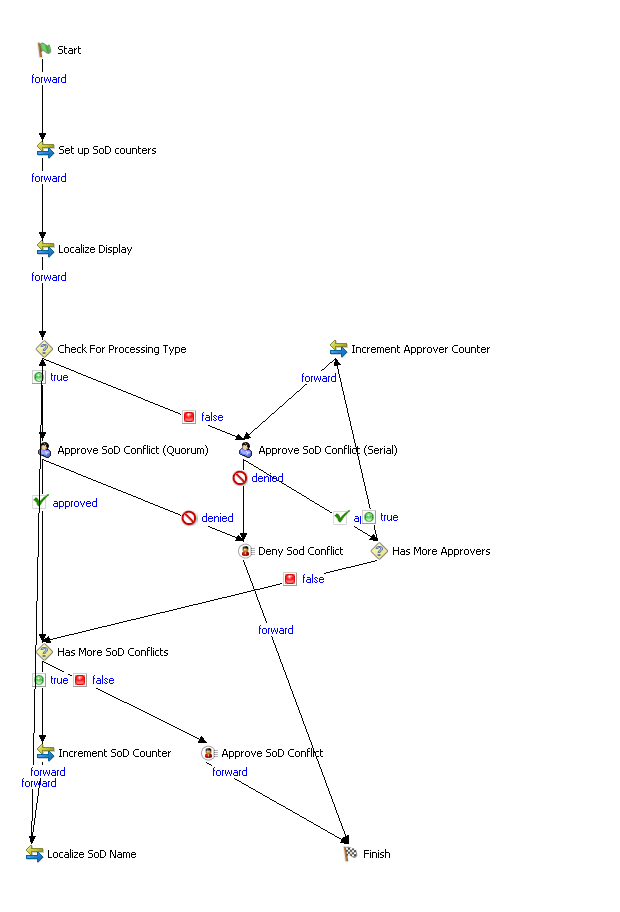
The components of the workflow are described in the following table:
Table 6-12 Standard SoD Constraint Exception Approval Workflow Activities
6.6.4 Customizing the Standard Separation of Duties Workflow
Separation of Duties conflict approval workflows are complex. Therefore, it is not recommended that you write a custom version. Rather, it is recommended that you add new activities to a copy of the standard SoD approval workflow. For example, you might want to add additional logging or messages. This example illustrates a customized workflow that includes a new logging activity.
Figure 6-9 Adding Activities to the SoD Workflow
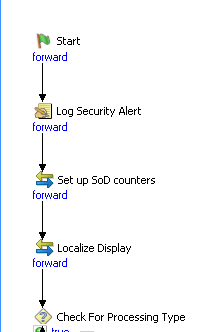
The Log Activity properties are shown in Figure 6-10.
Figure 6-10 Log Activity Properties

SoD Conflict approval workflows must follow the same rules as the role approval workflows as described on Section 6.6.2, Writing Custom Role Workflows.
